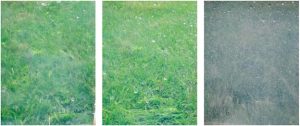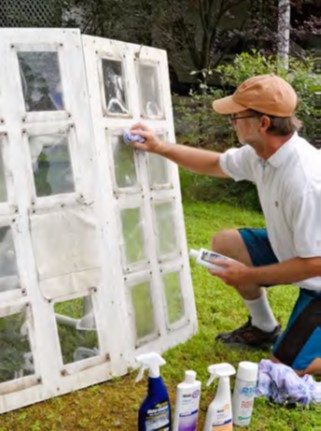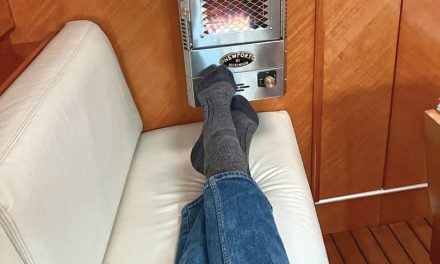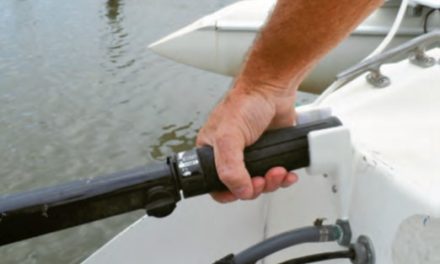Properly maintaining dodger and enclosure windows is a lot trickier than it looks.
Issue 140: Sept/Oct 2021
Perhaps the most fragile and vexing part of any boat’s exterior is the clear vinyl material commonly used in dodger and cockpit enclosure windows. The view through them is not always clear. They are annoying tattletales, recording every unintended brush with a tool or chafe with a line. They yield utterly to sunlight, yellowing and stiffening over time. They bleed plasticizers, turning sticky and attracting dirt. Even cleaning them can cause damage. And unlike a streak of mildew in the cockpit or an upholstery stain, we can’t just look away, not when we’re trying to look through.
After spending $1,500 for new canvas, I set out to learn about the vinyl windows sewn into it.

Drew’s backyard vinyl window experiment lasted five years. Here, he treats some of the panels.
For a story I researched and wrote for Practical Sailor magazine, I kept 50 vinyl window test panels in my side yard for five years. I faithfully applied polishes every quarter and cleaners every month. I used many brands of protectants, two brands of coated and uncoated vinyl window material, and I included untreated panels as controls for my experiment. Although the changes after five years were limited, I learned a lot.
The first thing I learned is that not all vinyl windows are the same. Some manufacturers of vinyl window products, like O’Sea and Strataglass, add a polyurethane coating to reduce surface abrasion and to seal the vinyl from oxygen and humidity. The thinking is that this coating is protection against the common vinyl window afflictions.
Unfortunately, although the coating adds minor scuff resistance, I’ve found that anything sharp or slightly gritty will cut through this surface coating like it’s butter. Even light rubbing against fabric straps and polished stainless tubing will take a toll over time. Any window near traffic areas, exposed to flapping sheets, or that is rolled up for ventilation or storage, will accumulate micro-scratches, scuffs, and a few deeper scratches. Even cleaning a window that was not first hosed off or using a cloth that is anything less than pristine is asking for damage. It’s nearly inevitable.
My conclusion is that while these coatings can’t hurt, they also can’t add the level of protection many hope for. Environmental aging happens and visibility slowly degrades. You polish it, but the scratches remain, and it’s not as easy to see through. One day, you realize the vinyl isn’t as supple as it once was. More time passes and you decide it’s downright brittle. Finally comes the day you notice that a crack has begun at one edge and is working its way across.
Is there anything that can be done to turn back the clock, to get a few more years of acceptable service, or even just to slow the damage?
Cover it Up
The only thing that dramatically and effectively delays vinyl window deterioration is a cover, such as one made from Sunbrella. I saw it firsthand on my last boat. In 22 years, I replaced the dodger windows three times. But the dodger also featured overhead skylights made from the same material, and I nearly always kept these panels covered.

The skylight panels in Drew’s dodger are still clear after 21 years, longevity he attributes to keeping them protected with a close-fitting cover as often as possible.
Those skylights were still pristine the day I sold the boat. The covers protected the vinyl window material from UV damage as well as bird bombs and atmospheric contaminants, thus reducing the need for cleaning, which itself is damaging (more on this later). All that said, it’s worth noting that the wrong cover, one that rubs or flaps against the vinyl it’s protecting, will cause damage. In my case, the covers were close-fitting to the point of creating a little gap between the Sunbrella and the skylights. Perfect.
Wax On, Wax Off?
UV is the big vinyl window killer. While protectants on the market tout their ability to shield vinyl windows from UV damage, my experiments yielded no clear evidence that protectants measurably reduce that damage. Sunscreen on your body only lasts for a few hours, so why would we expect the UV properties of wax to last more than a few days, or a week at most? (The wax may remain in place longer, but the UV screening capability is expended in a few days.) Waxing will reduce the obviousness of minor scuffs for a few weeks, but frequent polishing may cause even more and deeper scratches.
However, there are some positives to using a vinyl window protectant:
- Vinyl windows polished with a protectant are more likely to stay clean. This is helpful, because cleaning vinyl windows can damage them, so less cleaning is better.
- Cream protective polishes temporarily mask micro-scratches. That said, it’s a catch-22, since most of the micro-scratches come from the cleaning process.
- In general, protectants reduce internal fogging of non-coated vinyl in wet conditions. Cream protectants in particular reduce internal fogging that results from high humidity and dew in windows that have been restored by buffing with compound (see the “Buff and Fluff” sidebar). But this is only required because the micro-scratches created by the restoration process provide water vapor a path inside.
- Polishing prevents the build-up of sticky plasticizer film.

Drew applies Star brite View Guard to his dodger’s panels. Note the cover pulled back.
Yet, these positives must be weighed against what protectants can’t do, and the risks that even applying a protectant present:
- Every time you touch or rub a vinyl window—even to polish with a protectant—scratching will result from the polishing process itself. To mitigate, I always hose windows off first, and I use freshly laundered cloths, but no process is perfect.
- Protectants cannot delay yellowing or stiffening.
- Protectants will not do anything to restore suppleness. While the vinyl may feel more flexible after polishing with a cream protectant, that’s just because the surface is smoother; flex testing at temperatures from 74°F to 0°F showed no change.
- If you choose to clean your windows with a product, those made by IMAR, 404, Plexus, Star brite, and Armada work well. Avoid furniture products because they leave a residue that builds up. Star brite View Guard is my favorite window cleaner, because it improves water sheeting and visibility.
My overall conclusion, though, is that benign neglect is best. Clean as needed with dishwashing liquid or a protective cleaner, but otherwise adopt a hands-off strategy to your windows and keep them covered whenever possible.
Restoration
Is it possible to bring a window back from the dead, after visibility has degraded, by using a magic restoration system? I’ve tried them all, carefully following provided instructions. Though I’ve concluded there are no miracles to erase a misspent youth, there is a path forward. I’ve learned the following about vinyl window restoration products:
- They cannot restore flexibility. Although the vinyl feels more flexible, it is a false impression caused by a smoother surface feel. No product that I tested achieved measurable results restoring or changing flexibility.
- They cannot reduce brittleness. Vinyl windows become less supple with age, and with temperature decreases. (Don’t even touch your vinyl windows when the thermometer drops below 50°F; you will risk cracking the vinyl.)
- They cannot buff out significant scratches. If you can feel a scratch with a fingernail, leave it alone; it’s hopeless. Scratches in hard plastic windows (polycarbonate and acrylic) can be compounded out, but scratches in soft vinyl cannot.
- They cannot remove or reduce yellowing due to UV damage. The damage is deep inside.

Shown on test panels in Drew’s yard, a restored panel fogs in damp weather; a new panel stays clear in damp weather; a polished panel becomes nearly opaque in heavy humidity.
All these “can’ts” aside, these products do provide some benefit:
- They can remove sticky plasticizer residue and the imbedded dirt it attracts.
- They can reduce surface yellowing associated with the dirt.
- They can buff out minor scuffs that you can see but not feel.
- They can provide a semi-durable coating to reseal the surface (porosity accelerates all the problems associated with vinyl windows).
The bottom line is that there is no magic cure for aged, deteriorated vinyl windows, but with a little attention and strategy, you can probably stretch a bit more life out of your windows. They’ll never look as good as they did new, but hopefully you’ll be able to see where you’re going.
Good Old Boat Technical Editor Drew Frye draws on his training as a chemical engineer and pastimes of climbing and sailing to solve boat problems. He cruises Chesapeake Bay and the mid-Atlantic coast in his Corsair F-24 trimaran, Fast and Furry-ous, using its shoal draft to venture into less-explored waters. He is most recently author of Rigging Modern Anchors (2018, Seaworthy Publications).
Thank you to Sailrite Enterprises, Inc., for providing free access to back issues of Good Old Boat through intellectual property rights. Sailrite.com





